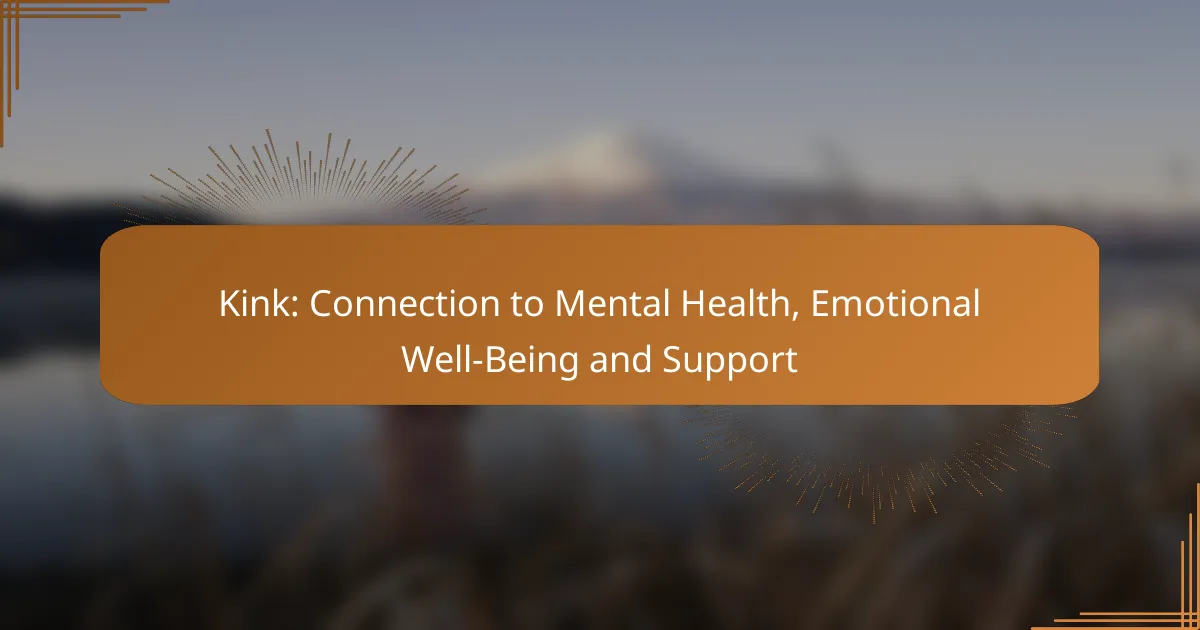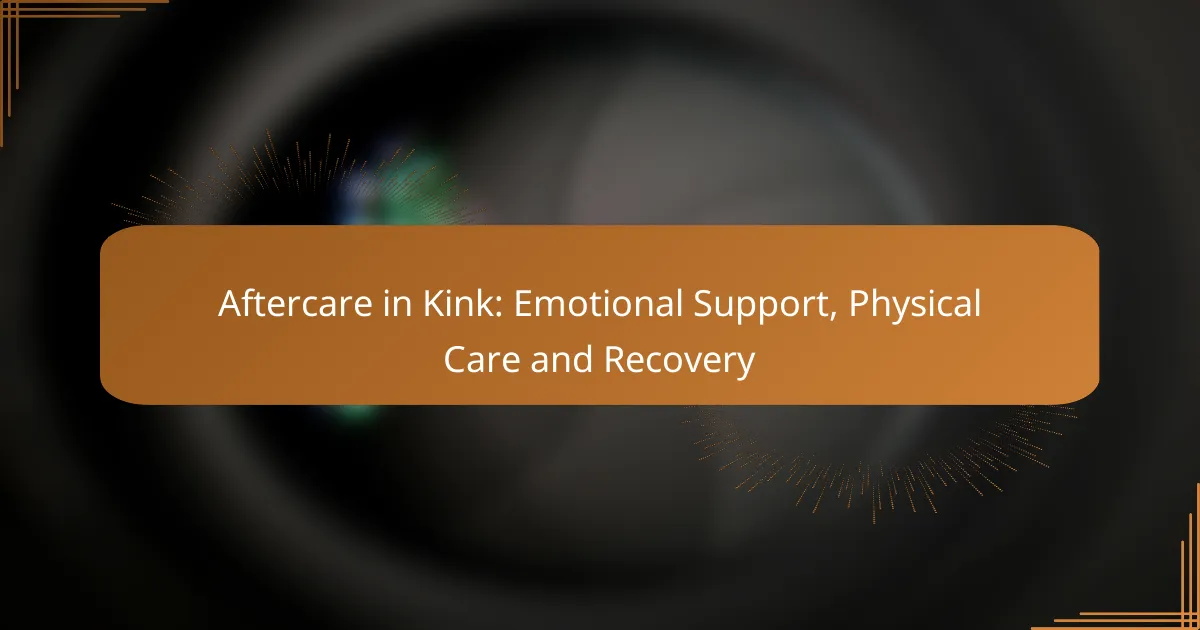Kink can play a vital role in mental health and emotional well-being, offering therapeutic benefits alongside potential challenges. By engaging in kink activities, individuals may experience enhanced intimacy, stress relief, and a sense of community, all of which contribute to improved emotional health. However, it is essential to navigate personal boundaries and mental health implications thoughtfully to maximize these benefits.

How does kink relate to mental health in the United States?
Kink can have a significant connection to mental health in the United States, offering both therapeutic benefits and potential challenges. Engaging in kink activities may enhance emotional well-being, foster connections, and provide a sense of community, but it also requires careful consideration of personal boundaries and mental health implications.
Positive impacts on mental health
Kink can promote mental health by providing a safe space for self-exploration and expression. Participants often report increased self-esteem and body positivity, as they embrace their desires and vulnerabilities in a consensual environment.
Additionally, kink communities can offer strong social support networks, helping individuals feel less isolated. The shared experiences and understanding among members can lead to improved emotional resilience and a sense of belonging.
Potential risks and challenges
While kink can be beneficial, it also presents risks that individuals should be aware of. Miscommunication or lack of consent can lead to emotional distress or trauma, underscoring the importance of clear boundaries and ongoing dialogue between partners.
Moreover, individuals with pre-existing mental health conditions may find that certain kink activities exacerbate their issues. It’s crucial to approach kink with mindfulness and to seek professional guidance if needed, ensuring that the experience remains positive and supportive.

What emotional benefits does kink provide?
Kink can offer significant emotional benefits, including enhanced intimacy and effective stress relief. Engaging in kink often fosters deeper connections and provides individuals with coping mechanisms to manage their emotional well-being.
Enhanced emotional intimacy
Participating in kink activities can strengthen emotional bonds between partners. The trust required in these dynamics encourages open communication and vulnerability, which can deepen intimacy.
For example, sharing fantasies or exploring limits together can create a safe space for partners to express their desires and fears. This shared experience often leads to a stronger emotional connection and a greater understanding of each other’s needs.
Stress relief and coping mechanisms
Kink can serve as a powerful tool for stress relief, allowing individuals to escape from daily pressures. Engaging in these activities can provide a sense of control and empowerment, which is beneficial for mental health.
Many people find that the physical sensations and mental focus involved in kink help them to release pent-up stress. Techniques such as [censured] or impact play can also promote mindfulness, drawing attention away from anxiety and into the present moment.

How can kink support emotional well-being?
Kink can significantly enhance emotional well-being by fostering a sense of belonging and providing a safe space for self-exploration. Engaging in kink activities often leads to improved self-esteem, emotional expression, and deeper connections with others.
Community support and connection
The kink community offers a unique support network that can be vital for emotional health. Many individuals find camaraderie and understanding among peers who share similar interests, which can alleviate feelings of isolation.
Participating in local or online kink groups can enhance social connections, providing opportunities to share experiences and advice. These interactions can lead to lasting friendships and a sense of belonging that is crucial for mental health.
Therapeutic practices in kink
Kink can serve as a therapeutic tool, allowing individuals to explore their emotions and boundaries in a controlled environment. Practices such as [censured] can promote trust and communication between partners, which are essential for emotional intimacy.
Engaging in kink can also facilitate emotional release, helping individuals process trauma or stress through physical sensations and role-play. It is important to approach these practices with clear communication and consent to ensure a safe and supportive experience.

What are the mental health resources for kink practitioners?
Mental health resources for kink practitioners include therapists who specialize in kink, as well as support groups and online communities. These resources can provide guidance, understanding, and a safe space for individuals to explore their interests while maintaining emotional well-being.
Therapists specializing in kink
Therapists who specialize in kink understand the unique dynamics and challenges that come with alternative sexual practices. They can provide tailored support, helping individuals navigate their feelings and experiences without judgment. Look for professionals with specific training in kink-friendly therapy or those who are part of organizations that promote sex positivity.
When seeking a kink-aware therapist, consider checking their credentials and experience. Many therapists offer initial consultations, which can help you determine if their approach aligns with your needs. It’s essential to feel comfortable and safe discussing your interests and any related concerns.
Support groups and online communities
Support groups and online communities offer a platform for kink practitioners to connect, share experiences, and receive support from peers. These groups can be found locally or online, providing flexibility for those who may not have access to in-person meetings. They often focus on various aspects of kink, including safety, consent, and emotional health.
Joining a support group can enhance your understanding of kink and foster a sense of belonging. Look for groups that prioritize inclusivity and respect for diverse identities and practices. Online platforms like forums and social media groups can also be valuable resources for finding information and connecting with others in the kink community.

What are the prerequisites for engaging in kink safely?
Engaging in kink safely requires a foundation of trust, communication, and mutual consent between all parties involved. Understanding the emotional and physical aspects of kink can enhance the experience while minimizing risks.
Consent and communication
Consent is the cornerstone of any kink activity. All participants must clearly agree to engage in specific practices, and this agreement should be ongoing and open to revision. Effective communication about desires, fears, and expectations can prevent misunderstandings and enhance the experience.
Before engaging in kink, it is essential to have a candid discussion about what each person is comfortable with. Using tools like safewords can help ensure that everyone feels secure and respected during the experience. Regular check-ins during the activity can also foster a supportive environment.
Understanding limits and boundaries
Recognizing personal limits and boundaries is crucial for safe kink practices. Each individual should identify their hard and soft limits—activities they absolutely will not engage in and those they might consider under certain conditions. This self-awareness helps create a safer and more enjoyable experience.
It can be helpful to create a list of activities that are acceptable and those that are off-limits. Discussing these boundaries with partners before engaging in kink can prevent potential discomfort or harm. Remember that boundaries can evolve, so ongoing dialogue is necessary to ensure everyone remains comfortable and safe.

How does kink intersect with sexual health?
Kink intersects with sexual health by emphasizing consent, communication, and safety practices. Engaging in kink can enhance emotional well-being and foster a deeper understanding of personal boundaries and desires, which are crucial for overall sexual health.
Safe practices in kink
Safe practices in kink involve establishing clear boundaries, using safe words, and ensuring informed consent among all participants. It is essential to communicate openly about limits and preferences before engaging in any activities.
Additionally, using appropriate safety gear, such as restraints or impact toys, can minimize risks. Regular check-ins during scenes help maintain comfort and safety, allowing participants to adjust or stop as needed.
Sexual health education resources
Numerous resources are available for sexual health education related to kink. Organizations like the American Association of Sexuality Educators, Counselors, and Therapists (AASECT) provide valuable information on safe practices and consent.
Online platforms, workshops, and local community groups often offer classes covering various aspects of kink and sexual health. Engaging with these resources can enhance knowledge and promote safer experiences within the kink community.

What emerging trends are shaping the kink community?
Emerging trends in the kink community reflect a growing acceptance and integration of kink practices into broader societal norms. These trends include increased visibility, acceptance, and the incorporation of kink into therapeutic practices, fostering a more supportive environment for individuals exploring their desires.
Increased visibility and acceptance
The kink community is experiencing heightened visibility, largely due to social media and online platforms that allow for open discussions about kink. This increased exposure has led to greater acceptance among the general public, reducing stigma and encouraging more individuals to explore their interests without fear of judgment.
As acceptance grows, more events and workshops are being organized, providing safe spaces for individuals to learn about and engage in kink practices. These gatherings often emphasize consent, safety, and community support, which are essential for healthy exploration.
Integration of kink in mainstream therapy
Therapists are increasingly recognizing the benefits of incorporating kink into their practices, particularly for clients seeking to understand their sexual identities and desires. This integration can help individuals process trauma, enhance intimacy, and improve communication skills within relationships.
Therapists may use kink-related exercises to facilitate discussions about boundaries, consent, and emotional well-being. It is crucial for practitioners to approach these topics with sensitivity and an understanding of the diverse experiences within the kink community.



